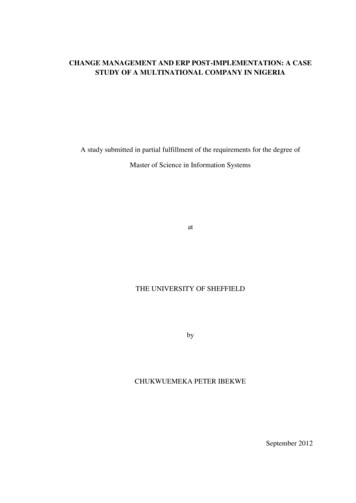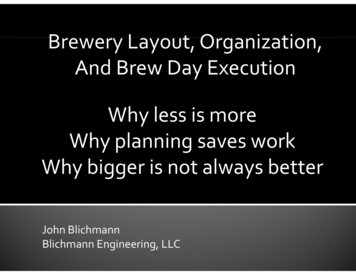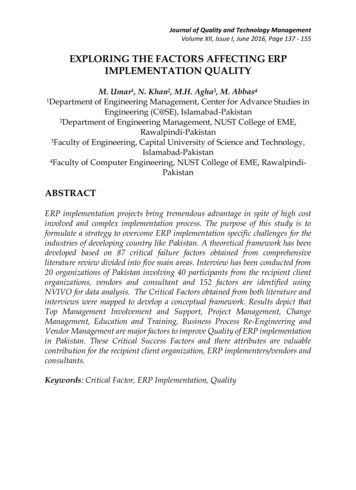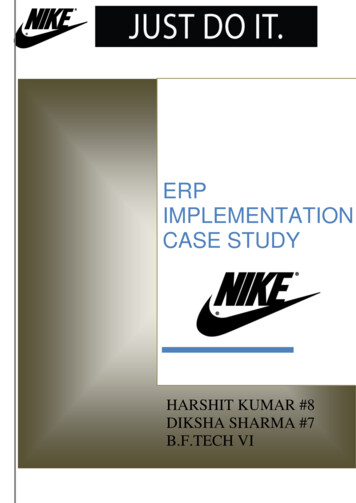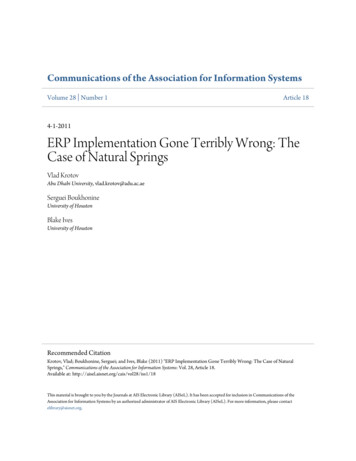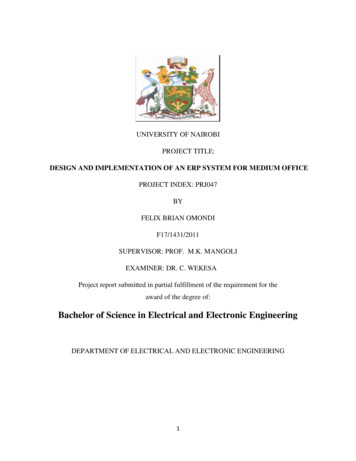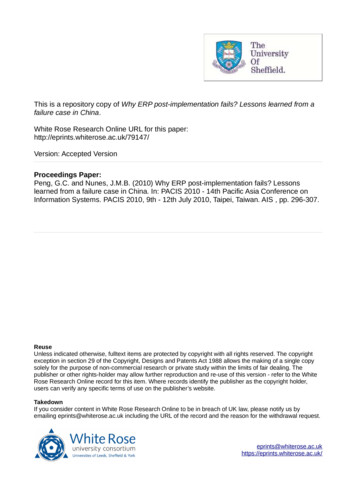
Transcription
This is a repository copy of Why ERP post-implementation fails? Lessons learned from afailure case in China.White Rose Research Online URL for this : Accepted VersionProceedings Paper:Peng, G.C. and Nunes, J.M.B. (2010) Why ERP post-implementation fails? Lessonslearned from a failure case in China. In: PACIS 2010 - 14th Pacific Asia Conference onInformation Systems. PACIS 2010, 9th - 12th July 2010, Taipei, Taiwan. AIS , pp. 296-307.ReuseUnless indicated otherwise, fulltext items are protected by copyright with all rights reserved. The copyrightexception in section 29 of the Copyright, Designs and Patents Act 1988 allows the making of a single copysolely for the purpose of non-commercial research or private study within the limits of fair dealing. Thepublisher or other rights-holder may allow further reproduction and re-use of this version - refer to the WhiteRose Research Online record for this item. Where records identify the publisher as the copyright holder,users can verify any specific terms of use on the publisher’s website.TakedownIf you consider content in White Rose Research Online to be in breach of UK law, please notify us byemailing eprints@whiterose.ac.uk including the URL of the record and the reason for the withdrawal terose.ac.uk/
promoting access to White Rose research papersUniversities of Leeds, Sheffield and Yorkhttp://eprints.whiterose.ac.uk/This is an author produced version of a paper published in PACIS 2010 - 14thPacific Asia Conference on Information Systems.White Rose Research Online URL for this d paperPeng, G.C. and Nunes, J.M.B. (2010) Why ERP post-implementation fails?Lessons learned from a failure case in China. In: PACIS 2010 - 14th Pacific AsiaConference on Information Systems. PACIS 2010, 9th - 12th July 2010, Taipei,Taiwan. AIS , pp. 296-307.http://www.pacis-net.org/index.jsp?t proceeding&y 2010White Rose Research Onlineeprints@whiterose.ac.uk
WHY ERP POST-IMPLEMENTATION FAILS? LESSONSLEARNED FROM A FAILURE CASE IN CHINAGuo Chao Peng, Department of Information Studies, University of Sheffield, Sheffield, UK,g.c.peng@shef.ac.ukMiguel Baptista Nunes, Department of Information Studies, University of Sheffield,Sheffield, UK, j.m.nunes@shef.ac.ukAbstractWhen thousands of Chinese companies have implemented ERP systems as a means of optimisingbusiness processes and improving management efficiency, how to realise the full benefits promised bythese systems and achieve continuous ERP success emerges to be the real challenge faced bypractitioners. This paper reports on an empirical study that aimed to examine and explore factorsthat can affect ERP performance and even trigger ERP post-implementation failure in the Chinesecontext. The research took a Chinese manufacturing firm, which recently failed in ERP exploitation,as a case study. It adopted an inductive research design supported by in-depth interviews andparticipative observation as the main methods of data collection. The findings identified that ERPexploitation failure in the case company was not just caused by technical pitfalls of the system, butmore importantly was also attributed to critical problems related to top management, IT professionaland system users. By drawing on the findings of the case study, the researchers identified a list ofkey lessons and recommendations that are valuable for helping Chinese companies to play moresuccessfully in ERP usage and exploitation.Keywords: ERP, Post-Implementation, Exploitation, Failure, China.
1INTRODUCTION AND BACKGROUND OF STUDYTraditionally, information systems (IS) were developed by using different data repositories andprogramming languages to support a single business area. These IS applications are very often totallyisolated and cannot exchange data with each other, which resulting in very low efficiency of their usebut extremely high maintenance cost (Peng and Nunes, 2008). This phenomenon is described as“islands of automation” (Loonam and McDonagh, 2005), which is widely perceived as one of themajor challenges faced by the IT industry in the 1970s and 1980s (Laudon and Laudon, 2006).Enterprise Resource Planning (ERP) systems, which are cross-functional IS packages, emerged in the1990s as an essential solution towards resolving this IS integration issue (Laudon and Laudon, 2006).ERP consists of a set of software modules that aim to collect data from various key overlappingbusiness processes, as well as storing the collected data in a single and comprehensive database wherethey can be shared by other parts of the firm. As a consequence, ERP allows information that waspreviously fragmented in different isolated systems to flow seamlessly throughout the entire business,and also facilitates company to integrate its discrete business processes from different functions intoenterprise-wide processes (Shehab et al., 2004; Laudon and Laudon, 2006; Peng and Nunes, 2008).These features of ERPs have resulted in a continuing high implementation rate of such integratedsystems in modern companies in recent years (Buonanno et al., 2005). In China in particular,companies often set ERP implementation as a top priority in their IS development agenda (Pan et al.,2009). In light of this fact, China’s ERP sales has grown dramatically from US 70 million in 2000 toUS 1.04 billion in only the first half-year of 2008 (Liang and Xue, 2004; Peng and Nunes, 2009a).However, when more and more companies reached the “go-live” milestone of their ERPs, how toachieve the full capacities and benefits of the system in the post-implementation phase emerge to bethe real challenges faced by practitioners (Willis and Willis-Brown, 2002; Peng and Nunes, 2009b).In particular, Liang and Xue (2004) stress that ERP innovation is an ongoing process during whichmany conditions could change. Thus, even if the system is implemented, it does not necessarily leadto efficient ERP performance in the long run, which in turn can significantly impact on businesscompetence (Gattiker and Goodhue, 2005).Due to these facts, ERP post-implementation emerges as an increasingly important topic that requiresimmediate attention from IS researchers. However, despite the need for research in this area, currentstudies on ERPs focus largely on system implementation and project management issues (e.g. Guptaet al., 2004; Kim et al., 2005; Woo, 2007). In contrast, there is a scarcity of studies addressing theorganisational exploitation of ERPs after the implementation phase (Peng and Nunes, 2009b).As one of the few exceptions the study of Liang et al. (2007), published in MIS Quarterly,investigated how institutional pressures and top management commitment can affect ERP assimilationand the degree of its usage. Another recent research by Peng and Nunes (2010a) identified a range ofcultural, organisational, and technical barriers and risks that can trigger ERP post-implementationfailure in China. However, when these previous studies produced a set of generalisable findings byusing cross-sectional questionnaires, they did not explore in-depth human insights into the ERPexploitation issues under investigation. Given the close link between ERP and its application context(Xue et al, 2005), there is a clear need of more in-depth case studies to investigate the postimplementation phenomenon in different specific contexts (e.g. China).The realisation of these research gaps motivated our in-depth case study presented in this paper. Thisempirical study focused on a failure case of ERP post-implementation in China. By using in-depthinterviews and participative observation, the study identified and explored inductively a set of criticalfactors and issues that led to ERP exploitation failure in the context of a Chinese manufacturing firm.By drawing on the findings of the case study, the researchers identified a list of key lessons that arevaluable for helping Chinese companies to play more successfully in ERP usage and assimilation.The paper is structured as follows: the next section presents the research methodology and the casecompany in details. Subsequently, the research findings are presented, followed by a discussion ofthe lesson learned. The last section discusses the implications of the study, with conclusions drawn.
2RESEARCH METHODOLOGY2.1Research Question and Case Study ApproachThe research reported in this paper aimed to answer the question:“What factors will make ERP fail in the post-implementation phase in Chinese firms?”According to Saunders et al. (2003), a case study is especially capable of generating answers to“what” research questions as the one set out above. Furthermore, ERP post-implementation is acontext-related phenomenon. As such, it is difficult to draw an explicit line to separate ERP from itsapplication context (Pan et al., 2009; Xue et al, 2005; Newell et al, 2000). Therefore, when a casestudy is particularly useful in obtaining in-depth qualitative evidence to investigate “a contemporaryphenomenon within its real-life context” (Yin, 2003; Eisenhardt, 1989; Benbasat et al., 1987), thesuitability of a case research approach is further justified. Given these considerations, a case studydesign was adopted for this research.However, it should be noted that given the limitation of the case-study, the results of the research willnot be easily generalisable to all companies in China. In other words, the above research question canonly be partially addressed by this paper. Nevertheless, it is hoped that the study, together withforegoing IS research (Liang et al., 2007; Peng and Nunes, 2010a), will provide researchers withdeeper insights into ERP post-implementation issues in the Chinese context.2.2Case DescriptionThe Chinese company involved in this case study is NYE (the real name of the firm is disguised forconfidentiality purposes). NYE is a state-owned enterprise (SOE), which has over 58-yearoperational history. It currently employs about 450 staff, with annual revenue of 170 million RMB.In the 1990s, the company was the largest manufacturer of electronic and telecommunication products(e.g. TVs, hi-fis, DVD players) in the Guangdong region in China. However, due to the country’scontinuous economic reform and the entrance of foreign companies into the gradually open Chinesemarket, China’s business environment has become increasingly competitive (Peng and Nunes, 2009a).As a consequence, NYE is experiencing escalating economic and market pressure in recent years.Moreover, in response to the national SOE reform policy (Garnaut et al., 2005:46-50; Yusuf et al.,2006:156-157), the company underwent a process of internal restructure and transformation in 2002.After this institutional reform, NYE can no longer receive substantial support (e.g. funds and financialsupport) from the government as it did in the past. This change has certainly raised furtheroperational and financial problems in the firm.Faced with these very hard conditions, in 2003 NYE implemented ERP as a means of replacing itslegacy systems to improve efficiency and competitiveness. However, after using the system for anumber of years, the company experienced a set of critical ERP exploitation problems, which mademanagers and users perceive that the ERP investment was in fact a significant failure.2.3Data CollectionIn order to identify and explore ERP exploitation challenges and issues in NYE, this case studyfollowed an inductive approach. In-depth interview was used as the main method of data collection,which is supplemented by participative observation to enable triangulation (Yin, 2003).The interview schedule was semi-structured and used open-ended questions that focused on eachinterviewee’s understanding of, experience with, and concerns about the implemented ERP systemand its usage. Different sets of interview questions were developed and used to explore ERP issuesrelated to the roles of interviewees (e.g. IT manager, system users). Moreover, all interviewinstruments were originally developed in English and then translated into Chinese (which is the native
language of all interviewees). The Chinese version of the interview instruments was one that beingused. Consequently, 18 in-depth interviews were conducted with key members that have directengagement with ERP in the firm, namely the managing director, the IT manager, and managers andusers in the four main departments (i.e. sales, financial, production, and purchasing department)(Table 1). All interviews were digitally recorded with prior permission, and lasted for 40 minutes to 1hour. In order to enhance the trustworthiness of data (Robson, 2002; Saunders et al., 2003), writtentranscription was done on the same day that the interview had taken place.PositionManaging directorIT manager and staffDepartmental managers in:Sales areaFinancial areaProduction areaPurchasing areaSystem users in:Sales areaFinancial areaProduction areaPurchasing areaTotalTable 1.Number131111233218Number and positions of interviewees.In addition, participative observation was used to gain further insights about how the current ERPsystem was actually used and exploited by its daily users in the company. This participativeobservation was conducted using a structured observation schedule that framed the process itself andenabled the researcher to interact with the informants. Conversations and activities were recorded bytaking notes and the use of a field diary.2.4Data AnalysisThe data collected was analysed by using a thematic analysis approach. Thematic analysis is one ofthe predominant techniques to be used for analysing qualitative data (Christofi et al., 2009). It is aprocess of searching, identifying and exploring codes and themes that emerged as “important to thedescription of the phenomenon” (Daly et al., 1997), through “careful reading and re-reading of thedata” (Rice and Ezzy, 1999:258). Fol
these systems and achieve continuous ERP success emerges to be the real challenge faced by practitioners. This paper reports on an empirical study that aimed to examine and explore factors that can affect ERP performance and even trigger ERP post-implementation failure in the Chinese context. The research took a Chinese manufacturing firm, which recently failed in ERP exploitation,



